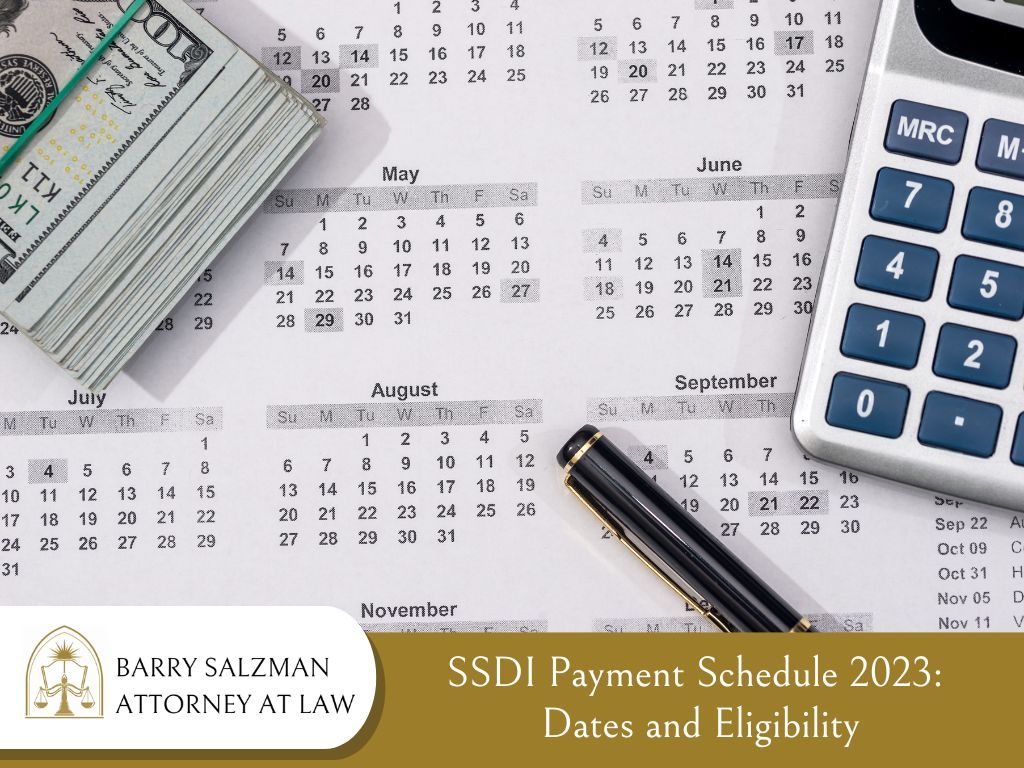SSDI Payment Schedule 2023: Dates and Eligibility

If you or someone you care about relies on Social Security Disability Insurance (SSDI) benefits, it is crucial to stay informed about the payment schedule for 2023. SSDI offers financial assistance to individuals who cannot work due to a disability. In this article, we will provide an overview of the SSDI payment schedule for 2023, discuss eligibility criteria, and address common questions regarding these benefits.
SSDI Payment Schedule for 2023
The Social Security Administration (SSA) has designated specific payment dates for recipients of Social Security Disability Insurance (SSDI) in 2023. These payments are generally disbursed on the second, third, or fourth Wednesday of each month, depending on the individual’s birthdate. Provided below is the schedule outlining the SSDI payment dates for the year 2023.
| Birthdate on the: | Payment Date |
| 1st – 10th | Second Wednesday |
| 11th – 20th | Third Wednesday |
| 21st – 31st | Fourth Wednesday |
Please be aware that payments are made in arrears, which means that you will receive your January benefit in the following month, specifically in February. If your payment date falls on a federal holiday or weekend, you can typically expect to receive your benefit on the business day just prior.
Social Security Disability Benefits Pay Chart for 2023
Please find below a comprehensive payment schedule for each month of the year 2023.
| Birth dates on 1st-10th | Birth dates on 11th-20th | Birth dates on 21st-31st | |
| January | 1/11 | 1/18 | 1/25 |
| February | 2/8 | 2/15 | 2/22 |
| March | 3/8 | 3/15 | 3/22 |
| April | 4/12 | 4/19 | 4/26 |
| May | 5/10 | 5/17 | 5/24 |
| June | 6/14 | 6/21 | 6/28 |
| July | 7/12 | 7/19 | 7/26 |
| August | 8/9 | 8/16 | 8/23 |
| September | 9/13 | 9/20 | 9/27 |
| October | 10/11 | 10/18 | 10/25 |
| November | 11/8 | 11/15 | 11/22 |
| December | 12/13 | 12/20 | 12/27 |
Eligibility Criteria
To be eligible for SSDI benefits in 2023, you must meet specific criteria that determine your qualification. These criteria encompass various factors, ensuring that individuals who meet them can avail themselves of the benefits they deserve.
1. Work Credits: To qualify for SSDI, it is necessary to have accumulated sufficient work credits based on your employment history. The specific number of credits required varies depending on your age and the time of disability onset.
2. Disability Status: It is necessary to have a medically determinable disability that is expected to last for at least one year or result in death. The Social Security Administration follows a rigorous definition of disability, which mandates that your condition significantly impairs your ability to engage in substantial gainful activity.
3. Five-Month Waiting Period: After becoming disabled, there is a mandatory waiting period of five months that must be observed before receiving benefits.
4. Non-Substantial Work: While receiving SSDI benefits, it is important to note that engaging in significant work activity is restricted. There are specific income limits in place, and surpassing them can lead to a potential reduction or discontinuation of benefits.
Applying for SSDI

If you believe that you meet the requirements for SSDI benefits, you have two options for applying. The first is to visit the SSA website, where you can complete the application online. Alternatively, you can reach out to your local Social Security office for assistance.
During the application process, you will need to provide detailed information about your medical condition, work history, and other relevant documentation. This may include medical records, statements from your doctors, and a thorough overview of your work history.
To increase your chances of a successful application, it is advisable to consult with a legal or financial professional or an advocate experienced in disability claims. Remember, applying for SSDI benefits can be complex, but with the right support from a Social Security Disability Attorney, you can navigate it successfully. Their expertise can greatly assist you throughout the process.
Frequently Asked Questions
Here are answers to some common questions about SSDI payments:
1. How can I check the status of my SSDI payment?
To ascertain the status of your payment, you have two options: create an online account on the SSA website or get in touch with your local Social Security office. By doing so, you can conveniently stay informed about your payment status.
2. Can I work while receiving SSDI benefits?
While receiving SSDI benefits, you have the option to work part-time or engage in “trial work”, but it’s important to note that there are income limits. For specific details, it is advisable to consult the SSA.
3. Will my SSDI payment amount change in 2023?
SSDI payment amounts are subject to annual adjustments to reflect cost-of-living increases. For the most up-to-date payment rates, please refer to the SSA website.
Conclusion

It is vital for individuals who depend on SSDI benefits to have a thorough understanding of the 2023 payment schedule and eligibility criteria. By staying well-informed and meeting the necessary requirements, people with disabilities can ensure a reliable source of financial support. It is important to stay updated on any changes or updates to the SSDI program and seek professional assistance if needed to navigate the application process effectively. For expert guidance, schedule an appointment online today or call (727) 321-4993.
Schedule Your Consultation Today
Navigating the bureaucracy of any disability program is complex and frustrating and often ends in denial.
Don't do it alone! Have a dedicated, experienced advocate on your team.
Fill out the form below or give us a call at 727-321-4993.



